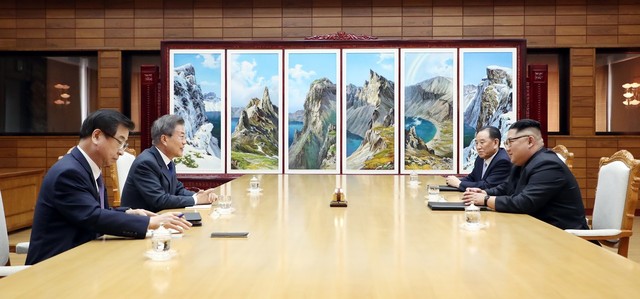 |
|
South Korea President Moon Jae-in and North Korean leader Kim Jong-un engage in an inter-Korean summit at the Unification House (Tongilgak) building on the North Korean side of Panmunjeom on May 26. (provided by Blue House)
|
North Korean leader proposed inter-Korean summit less than 24 hours after Trump’s cancellation
The inter-Korean summit at Panmunjeom on May 26 came about after North Korean leader Kim Jong-un reached out to South Korean President Moon Jae-in in an attempt to somehow save his summit with US President Donald Trump, which was in danger of being scrapped. Many experts are struck by Kim’s pragmatic attitude and strategic behavior, his candid display of desperation and his persistent pursuit of his goals. Kim’s unconventional style also makes a striking contrast with his father and former North Korean leader Kim Jong-il. “On the afternoon of the day before yesterday [May 25], Chairman Kim conveyed his desire to hold a casual meeting, and I gladly accepted,” President Moon said on May 27. In effect, Kim proposed an “emergency meeting” with President Moon less than 24 hours after Trump summarily canceled the North Korea-US summit on the evening of May 24. This has led experts to describe Kim’s leadership style as being “pragmatic” and “goal-oriented,” without any hang-ups about formality. “The North probably also had some behind-the-scenes contact with the US, but it asked South Korea to serve as a kind of ‘guide.’ This marks a change from North Korea’s past pattern of behavior. It’s a rather pragmatic kind of approach,” said Koo Kab-woo, professor at the University of North Korean Studies. “It’s surprising that Kim would turn to inter-Korean dialogue to reach a breakthrough in a deadlock in dialogue with the US. This is really groundbreaking,” Koo said. “Though North Korea hinted at its commitment to the North Korea-US summit in the statement by Kim Kye-gwan [on May 25], it’s commendable that Kim Jong-un went beyond that to take personal action.” Kim also showed he is less concerned with protocol than results in his summit with Chinese President Xi Jinping. Just 40 days after his first summit with Xi in late May, Kim abruptly visited Dalian, in China’s Liaoning Province, on May 7 and 8 for a second meeting with Xi. The fact that Kim made a second visit to China even after Xi had promised to pay a return visit to Pyongyang reflects his diplomatic style, which pays little attention to format or protocol. Kim’s proposal to hold a summit also suggests that he is serious about implementing the pledge in the Panmunjeom Declaration “to hold frequent and candid discussions on issues vital to the nation [. . .] through regular meetings and direct telephone conversations.” “Given [Kim’s] intense drive to achieve the tasks and goals he has set for himself, he appears determined to ensure that the [inter-Korean] agreement does not remain a mere scrap of paper,” said a former senior official who is familiar with inter-Korean relations. “While Kim no doubt has his own strategic goals, his diplomatic style appears to be that of practicing what he preaches,” said Cho Sung-ryul, senior research fellow for the Institute for National Security Strategy. If Kim is to achieve his goal of bringing North Koreans “a prosperous and civilized lifestyle” that they “can be proud of” (as he promised during a plenary meeting of the Korean Workers’ Party on Apr. 20), he must engineer an end to the economic sanctions imposed by the US and the UN and attract capital from overseas. To do that, Kim apparently feels, it is necessary to hold a successful summit with the US, a feeling that seems to be reflected in his groundbreaking proposal for the summit with President Moon. In his closing remarks after the summit on May 26, Kim expressed his hope that the two leaders would do their best to bring about good results. By Noh Ji-won, staff reporter Please direct comments or questions to [english@hani.co.kr]






